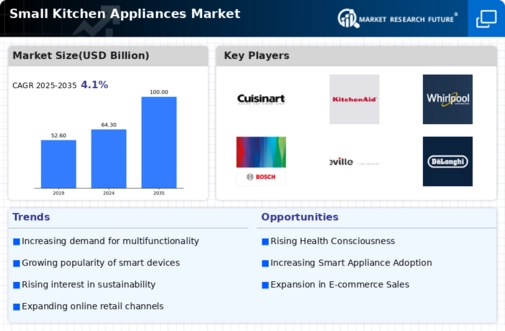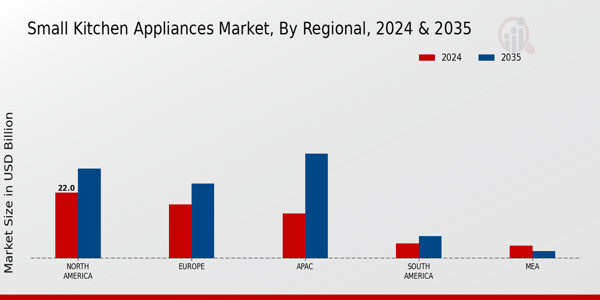Rising Urbanization
The Global Small Kitchen Appliances Market Industry is experiencing growth driven by increasing urbanization. As more individuals move to urban areas, the demand for compact and efficient kitchen solutions rises. Urban dwellers often have limited space, leading to a preference for small kitchen appliances that maximize functionality without occupying excessive space. This trend is particularly evident in densely populated cities where convenience and efficiency are paramount. The market is projected to reach 64.3 USD Billion in 2024, reflecting the growing need for innovative kitchen solutions that cater to urban lifestyles.
Market Growth Projections
The Global Small Kitchen Appliances Market Industry is poised for substantial growth, with projections indicating a market size of 64.3 USD Billion in 2024 and an anticipated increase to 100 USD Billion by 2035. This growth trajectory suggests a compound annual growth rate of 4.1% from 2025 to 2035. The expansion is driven by various factors, including urbanization, technological advancements, and changing consumer preferences towards convenience and health. As the market evolves, it is likely to witness the introduction of innovative products that cater to diverse consumer needs, further enhancing its growth potential.
Health and Wellness Trends
The growing emphasis on health and wellness is significantly influencing the Global Small Kitchen Appliances Market Industry. Consumers are increasingly seeking appliances that facilitate healthier cooking methods, such as air fryers and steamers. These appliances allow for the preparation of nutritious meals with minimal oil and fat, aligning with contemporary dietary preferences. As awareness of health issues rises, the demand for appliances that support healthy eating habits is likely to increase. This trend is expected to contribute to a compound annual growth rate of 4.1% from 2025 to 2035, reflecting the market's adaptability to changing consumer preferences.
Technological Advancements
Technological advancements play a crucial role in shaping the Global Small Kitchen Appliances Market Industry. Innovations such as smart appliances, which can be controlled via smartphones, enhance user convenience and efficiency. For instance, smart coffee makers and programmable slow cookers are gaining popularity as they offer personalized cooking experiences. The integration of IoT technology into kitchen appliances is likely to attract tech-savvy consumers, further driving market growth. As the industry evolves, the introduction of energy-efficient and multifunctional appliances is expected to contribute to the market's expansion, potentially reaching 100 USD Billion by 2035.
Convenience and Time-Saving
The fast-paced lifestyle of modern consumers drives the demand for convenience in the Global Small Kitchen Appliances Market Industry. Individuals are increasingly looking for appliances that simplify meal preparation and reduce cooking time. Multi-functional devices, such as pressure cookers and food processors, are particularly appealing as they combine several cooking methods into one appliance. This trend is evident in the rising popularity of meal prep appliances that allow users to prepare meals quickly and efficiently. As the market continues to evolve, the focus on convenience is likely to remain a key driver of growth, with projections indicating a market size of 64.3 USD Billion by 2024.
Sustainability and Eco-Friendly Products
Sustainability is becoming a pivotal factor in consumer purchasing decisions within the Global Small Kitchen Appliances Market Industry. As environmental awareness grows, consumers are increasingly inclined to choose eco-friendly appliances that minimize energy consumption and reduce waste. Manufacturers are responding by developing energy-efficient products that comply with environmental regulations and standards. This shift towards sustainability not only appeals to environmentally conscious consumers but also aligns with global efforts to combat climate change. The market is expected to see a rise in demand for sustainable kitchen appliances, contributing to a projected market value of 100 USD Billion by 2035.
















